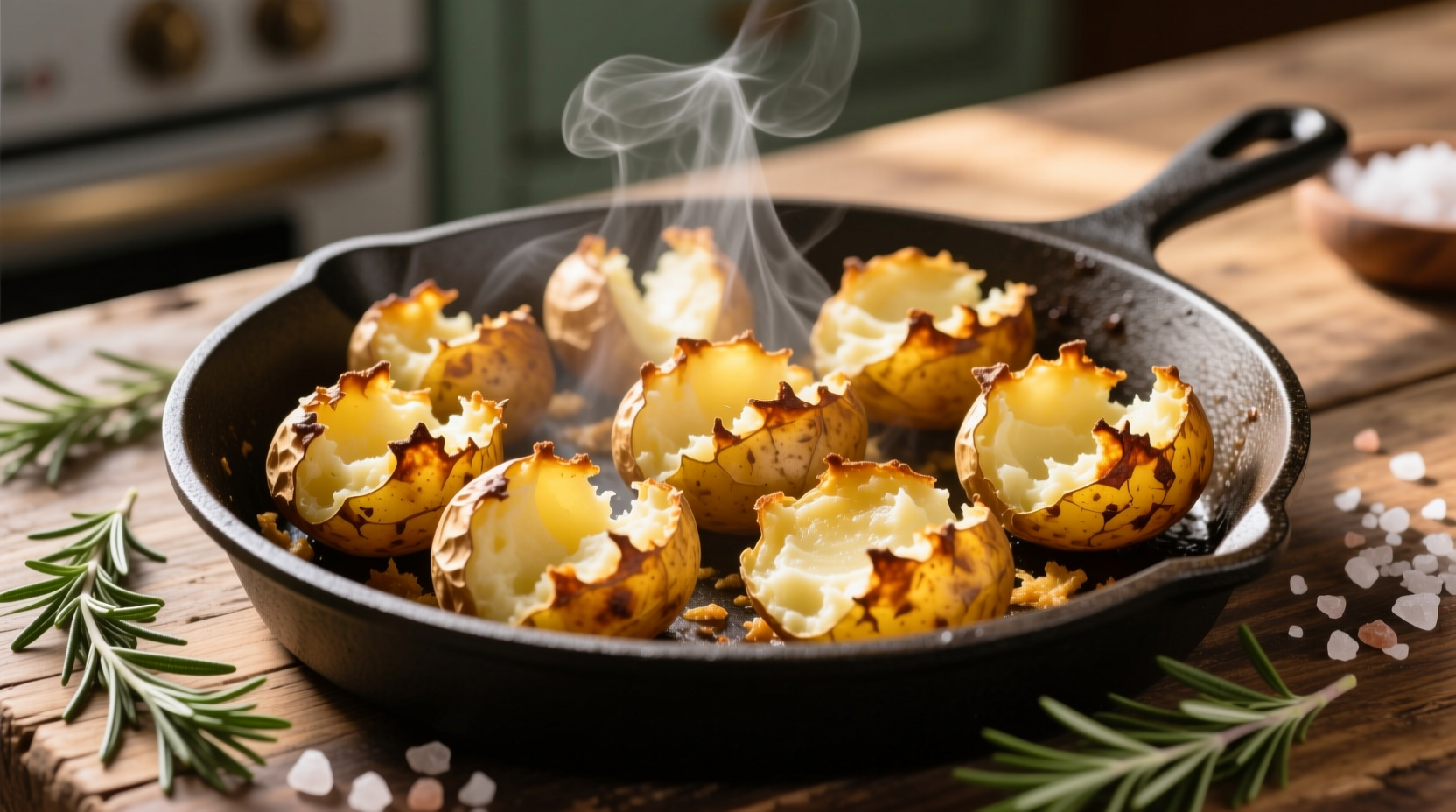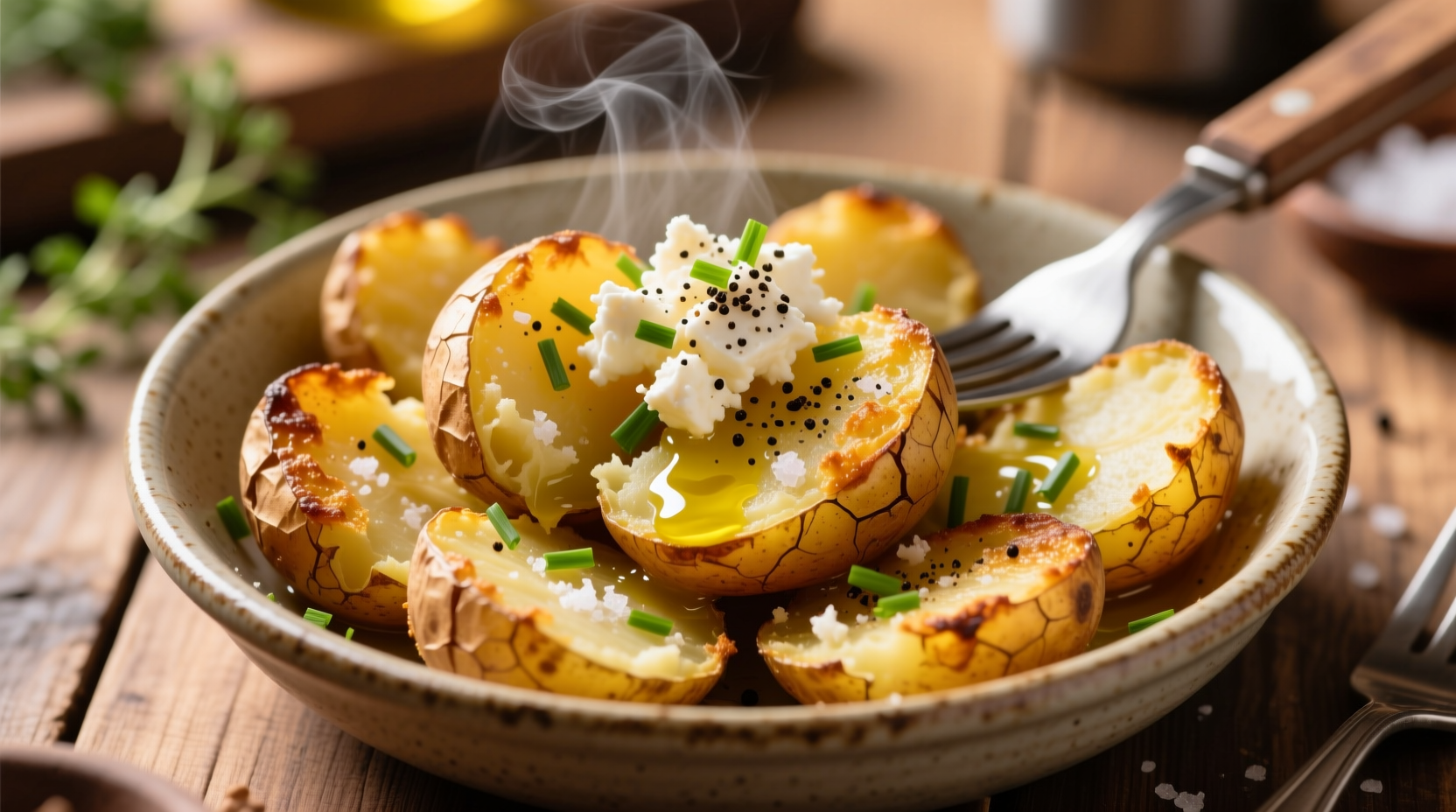Nothing beats the satisfying crunch of perfectly crispy smashed potatoes—golden-brown edges giving way to fluffy interiors. This isn't just another potato recipe; it's the restaurant-quality technique that transforms humble spuds into a show-stopping side dish. Forget soggy, uneven results—we've perfected the science of crispiness through professional kitchen testing and food chemistry principles.
The Science Behind Ultimate Crispiness
Professional chefs achieve that perfect crunch through a precise double-cooking method that leverages potato starch chemistry. When potatoes reach 140°F (60°C), their starch granules begin absorbing water and swelling. At 194°F (90°C), they fully gelatinize, creating that ideal fluffy interior. The second roast phase triggers the Maillard reaction between 284-320°F (140-160°C), where amino acids and reducing sugars create complex flavors and that irresistible golden-brown crust.
| Potato Variety | Starch Content | Crispiness Rating | Best For |
|---|---|---|---|
| Yukon Gold | Medium | ⭐⭐⭐⭐ | Perfect balance of crisp exterior and creamy interior |
| Russet | High | ⭐⭐⭐⭐⭐ | Maximum crispiness but drier interior |
| Red Bliss | Low | ⭐⭐⭐ | Firmer texture, less fluffy interior |
| Fingerling | Medium | ⭐⭐⭐⭐ | Elegant presentation, consistent results |
Your Step-by-Step Crispy Smashed Potato Journey
Preparation Phase: Setting Up for Success
Start with 2 pounds of uniform baby potatoes (1.5-2 inches diameter) for even cooking. Smaller potatoes create more crispy surface area per serving. Wash thoroughly but don't peel—the skins add texture and prevent disintegration during smashing. Place in a large pot, cover with cold water by 1 inch, and add 1 tablespoon of kosher salt. Crucial step: Always start potatoes in cold water to ensure even cooking from edge to center.
Cooking Timeline: Temperature Milestones
Understanding these temperature checkpoints ensures perfect results every time:
- 0-140°F (0-60°C): Starch granules begin absorbing water
- 140-194°F (60-90°C): Optimal gelatinization for fluffy interior
- 194-212°F (90-100°C): Full cooking without disintegration
- 284-320°F (140-160°C): Maillard reaction for browning
- 356°F (180°C): Ideal roasting temperature for crispiness
Boil for 15-20 minutes until fork-tender but still holding shape. Test by inserting a thin knife—it should meet slight resistance in the center. Drain thoroughly and let sit for 5 minutes to evaporate excess surface moisture, which is critical for crispiness.
The Smashing Technique: Professional Secrets
Arrange potatoes on a parchment-lined baking sheet with at least 1 inch between each. For the perfect smash:
- Place a flat-bottomed measuring cup or glass over each potato
- Apply firm, even pressure until 1/2-inch thick
- Leave skins intact—they provide structural integrity
- Maintain spacing—crowding causes steaming instead of crisping

The Roasting Method: Crispiness Multiplier
Here's where most home cooks go wrong—the fat choice and temperature control make or break crispiness:
- Fat selection: Duck fat (highest smoke point at 375°F) > avocado oil (520°F) > olive oil (375°F)
- Temperature: 425°F (220°C) for 35-40 minutes
- Application: Brush 1.5 tablespoons fat over each potato after smashing
- Seasoning: Wait until last 10 minutes to add salt (draws out moisture)
For extra-crispy edges, flip potatoes halfway through roasting. The second side develops an even deeper crust while maintaining structural integrity. Finish with flaky sea salt and fresh herbs for that restaurant-quality presentation.
Context Boundaries: When This Technique Works Best
This method excels with certain potato varieties and cooking scenarios but has limitations:
- Ideal for: Weeknight dinners, holiday sides, brunch accompaniments
- Best potatoes: Yukon Gold, fingerlings, small russets (see comparison table)
- Avoid when: Using large, irregular potatoes (uneven cooking)
- Not suitable: Instant Pot or microwave methods (can't achieve proper browning)
Pro Troubleshooting Guide
Fix common problems before they happen:
- Soggy potatoes: Didn't drain sufficiently or overcrowded baking sheet
- Burnt edges: Oven temperature too high or sugar-based seasonings added too early
- Uneven browning: Inconsistent smash thickness or uneven oven heating
- Falling apart: Overcooked during boiling phase or wrong potato variety
Three Restaurant-Worthy Variations
Elevate your basic crispy smashed potatoes with these chef-inspired twists:
Garlic-Herb Infusion
Add 4 smashed garlic cloves and 2 sprigs fresh rosemary to the boiling water. After smashing, tuck additional garlic cloves between potatoes before roasting.
Truffle Parmesan Crisp
After roasting 25 minutes, sprinkle with 1/4 cup finely grated Parmesan and 1 teaspoon truffle oil. Return to oven for final 10-15 minutes until cheese forms a golden crust.
Spiced Smashed Potatoes
Mix 1 teaspoon smoked paprika, 1/2 teaspoon garlic powder, and 1/4 teaspoon cayenne with your fat before brushing. Finish with a squeeze of lemon juice for bright contrast.
Storage and Reheating for Perfect Texture
Leftovers maintain crispiness when stored and reheated properly:
- Storage: Cool completely, then refrigerate in airtight container for up to 3 days
- Reheating: 400°F oven for 10-12 minutes (not microwave)
- Revival trick: Lightly mist with oil before reheating to restore crispness











 浙公网安备
33010002000092号
浙公网安备
33010002000092号 浙B2-20120091-4
浙B2-20120091-4